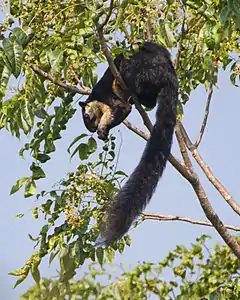Black giant squirrel
The black giant squirrel or Malayan giant squirrel (Ratufa bicolor) is a large tree squirrel in the genus Ratufa native to the Indomalayan zootope. It is found in forests from northern Bangladesh, northeast India, eastern Nepal, Bhutan, southern China, Myanmar, Laos, Thailand, Malaysia, Cambodia, Vietnam, and western Indonesia (Java, Sumatra, Bali and nearby small islands).[1]
| Malayan black giant squirrel | |
|---|---|
 | |
| Scientific classification | |
| Kingdom: | Animalia |
| Phylum: | Chordata |
| Class: | Mammalia |
| Order: | Rodentia |
| Family: | Sciuridae |
| Genus: | Ratufa |
| Species: | R. bicolor |
| Binomial name | |
| Ratufa bicolor (Sparrman, 1778) | |
| Subspecies[2] | |
| |
 | |
| Black giant squirrel range (erroneously missing Java and Bali) | |
| Synonyms | |
|
Tennentii, source: Layard, in Blyth, 1849 | |
Description

The black giant squirrel is one of the largest species of squirrel in the world. On average, an adult black giant squirrel weighs around 1.05–1.25 kg (2.3–2.8 lb), has a head–and–body length of 34–37 cm (13–15 in), and the tail is 41–42 cm (16–17 in) long. The subspecies R. b. condorensis of Vietnam's Côn Sơn Island averages only c. 30 cm (12 in) in head–and–body length and the tail 32 cm (13 in), but otherwise it resembles the typical subspecies.[3]
This species is typically distinctly bicoloured with dark upperparts and pale underparts. The back, top of the head, ears and bushy tail are deep brown to black and the underparts are light buff-coloured. In Sumatra, Java and Bali the hairs of the back and tail are light-tipped, making these sections appear relatively pale (however, the back is still distinctly darker than the underparts). On small islands off Myanmar and in the Strait of Malacca the black giant squirrel has reddish-yellowish underparts.[3]
Habitat
Ratufa bicolor's range includes a variety of bioregions that all share the commonality of being forested. It ranges in elevation from sea level up to at least 1,400 metres (4,600 ft), in some of the most rugged land in the world. However, in recent decades, R. bicolor's habitat has been steadily encroached upon by human settlement, timber harvesting and agriculture, which along with overhunting by human predation in parts of its range, has resulted in a total loss of up to 30% of the population in the past ten years.[1] However, in some places this species is protected from hunting by law or tradition.[1]
In South Asia R. bicolor dwells among tropical and subtropical coniferous and broadleaf forests.[1]
In Southeast Asia R. bicolor lives in tropical broadleaf evergreen and semi-evergreen forests, but is rarely seen in coniferous forests.[1]
In the tropical rainforest of the Malay Peninsula and Indonesia, R. bicolor is not as abundant as elsewhere in its range, which is probably due to competition from other arboreal species (especially primates) for food in the upper forest canopy.[1]
Among the better places to sight the black giant squirrel is the Kaziranga National Park in the state of Assam, India.[4]
Behavior
R. bicolor is diurnal and arboreal, but sometimes climbs down from the forest canopy to feed on the ground.[1] The black giant squirrel rarely enters plantations or settlements, preferring the wild forest.[1]
Its diet consists of seeds, pine cones, fruits, and leaves.[1] It is primarily solitary, and has a litter of from 1 to 2 young, which it raises in a drey (or nest), often located within a hollow space of a tree.[1]

Taxonomy
Further study is required to determine whether Ratufa bicolor actually represents several similar species.[1]
The table below lists the ten recognized subspecies of Ratufa bicolor, along with any synonyms associated with each subspecies:[2]
| Subspecies | Authority | Synonyms |
|---|---|---|
| R. b. bicolor | Sparrman (1778) | albiceps, baliensis, humeralis, javensis, leschnaultii, major, sondaica |
| R. b. condorensis | Kloss (1920) | none |
| R. b. felli | Thomas and Wroughton (1916) | none |
| R. b. gigantea | McClelland (1839) | lutrina, macruroides |
| R. b. hainana | J. A. Allen (1906) | stigmosa |
| R. b. leucogenys | Kloss (1916) | sinus |
| R. b. melanopepla | Miller (1900) | anambae, angusticeps, dicolorata, fretensis, penangensis, peninsulae, tiomanensis |
| R. b. palliata | Miller (1902) | batuana, laenata |
| R. b. phaeopepla | Miller (1913) | celaenopepla, marana |
| R. b. smithi | Robinson and Kloss (1922) | none |
References
- Walston, J.; Duckworth, J. W.; Molur, S. (2008). "Ratufa bicolor". IUCN Red List of Threatened Species. 2008. Retrieved 6 January 2009.CS1 maint: ref=harv (link)
- Thorington, R.W., Jr.; Hoffmann, R.S. (2005). "Ratufa bicolor". In Wilson, D.E.; Reeder, D.M (eds.). Mammal Species of the World: a taxonomic and geographic reference (3rd ed.). The Johns Hopkins University Press. pp. 754–818. ISBN 0-8018-8221-4. OCLC 26158608.
- Thorington, Jr., R.W.; J.L. Koprowski; M.A. Steele; J.F. Whatton (2012). Squirrels of the World. Baltimore: Johns Hopkins University Press. pp. 25–26. ISBN 978-1-4214-0469-1.CS1 maint: multiple names: authors list (link)
- Menon, Vivek (2009) [First published 2003]. Mammals of India. Princeton field guides. Princeton, N.J.: Princeton University Press. ISBN 978-0-691-14067-4. OCLC 276340775.
Originally published as: Menon, Vivek (ed.), et al. A field guide to Indian mammals (2003)
Bibliography
- Francis, Charles M., Priscilla Barrett. A field guide to the mammals of South-East Asia. London: New Holland, 2008. ISBN 978-1-84537-735-9, OCLC: 190967851.
- Lekhakun, Bunsong, Jeffrey A. McNeely. Mammals of Thailand. Bangkok: Association for the Conservation of Wildlife, 1977. OCLC: 3953763.
- Nowak, Ronald M. Walker’s mammals of the world. Baltimore: Johns Hopkins University Press, 1999. ISBN 978-0-8018-5789-8, OCLC: 39045218. Chapter: "Sciuridae: squirrels, chipmunks, marmots, and prairie dogs" in volume two.
External links
- Black Giant Squirrel - Ecology Asia page about this species, with beautiful photos and description.
